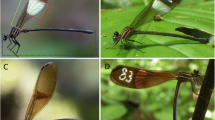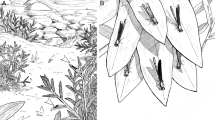Abstract
Habitat utilization patterns were studied in damselfly males,Mnais pruinosa, which have two male forms with different reproductive behaviors. The ‘esakii’ (orange-winged males) were territorial around oviposition sites, while the ‘strigata’ (hyaline-winged males) were non-territorial, often sneaking into theesakii's territory or loitering on the foliage of vegetation along stream banks. The place in the stream in the study area where females frequently appeared was covered by reeds and had abundant oviposition sites. It was difficult for the territorialesakii to stay there because the crowded reeds prevented them from defending their territory and discovering the females. Furthermore, there was competition for the limited territorial space with another species,Mnais nawai. Strigata males concentrated in this place in direct proportion to the number of females. Females frequently mated withstrigata males and probably deposited eggs fertilized bystrigata sperm rather thanesakii sperm. The density ofstrigata was higher than that ofesakii in this study area. If the average reproductive success ofesakii andstrigata males is equal, this may indicate that the equilibrious point between the two male forms is biased towardstrigata.
Similar content being viewed by others
References
Asahina S. (1976) A revisional study of the genusMnais (Odonata, Calopterygidae). VIII. A proposed taxonomy of JapaneseMnais.Tombo 19: 2–16.
Christiansen F. B. (1988) Frequency dependence and competition.Phil. Trans. R. Soc. Lond. B 319: 587–600.
Clarke B. C., &Partridge L. (1987)Frequency-dependent Selection. The Royal Society, London.
Dominey W. J. (1984) Alternative mating tactics and evolutionarily stable strategies.Am. Zool. 24: 385–96.
Dunbar R. I. M. (1982) Intraspecific variations in mating straregy.Perspectives in Ethology, vol. 5 (eds. P. P. G. Bateson & P. H. Klopfer), pp. 385–431. Plenum Press, New York.
Eguchi M. (1980) Population strategy of two species in genusMnais coexisting at the stream.J. Soc. Popul. Ecol. 33: 10–19 (in Japanese).
Endler B. E. (1991). Interactions between predators and prey,Behavioural Ecology: An Evolutionary Approach, 3rd edn (eds J. R. Krebs & N. B. Davies) pp. 169–202. Blackwell Scientific Publications, Oxford.
Grant B., Snyder, G. A. &Glessner A. F. (1974) Frequency-dependent mate selection inMormoniella vitripennis.Evolution 28: 259–64.
Gross M. R. (1984) Sunfish, salmon, and the evolution of alternative reproductive strategies and tactics in fish.Fish Production (eds R. J. Wootton & G. Potts) pp. 35–75. Academic Press, London.
Hagen, D. W. &Moodie G. E. E. (1979) Polymorphism for breeding colors inGasterosteus aculeatus. I. Their genetics and geographic distribution.Evolution 33: 641–8.
Hagen D. W., Moodie, G. E. E. &Moodie, P. F. (1980) Polymorphism for breeding colors inGasterosteus aculeatus. II. Reproductive success as a result of convergence for threat display.Evolution 34: 1050–9.
Hamilton W. D. (1979) Wingless and fighting males in fig wasps and other insects.Sexual Selection and Reproductive Competition in Insects (eds M. S. Blum & N. A. Blum) pp. 167–220. Academic Press, London.
Houde A. E. (1988) Genetic difference in female choice between two guppy populations.Anim. Behav. 36: 510–16.
Krebs J. R. &Davies N. B. (1991)Behavioral Ecology: An Evolutionary Approach, 3rd edn. Blackwell Scientific Publications, Oxford.
Maekawa K. &Onozato H. (1986) Reproductive tactics and fertilization success of mature male Miyabe charrSalvelinus malamiyabei.Envir. Biol. Fish 15: 119–29.
Manly B. F. J. (1971) Estimates of marking effect with capture-recapture sampling.Envir. Biol. Fish 8: 181–9.
Manly, B. F. J. &Parr M. J. (1968) A new method of estimating population size, survivorship and birth rate from capture-recapture data.Trans. Soc. Br. Entomol. 18: 81–9.
Maynard Smith J. (1976) Evolution and the theory of games.Am. Sc. 64: 41–5.
Maynard Smith J. (1989)Evolutionary Genetics. Oxford University Press, Oxford.
Nomakuchi S. &Higashi K. (1985) Patterns of distribution and territoriality in the two male forms ofMnais pruinosa pruinosa Selys (Zygoptera: Calopterygidae).Odonatologica 14: 301–11.
Nomakuchi S., Higashi K., Harada M. &Maeda M. (1984). An experimental study of the territoriality inMnais pruinosa pruinosa Selys (Zygoptera: Calopterygidae).Odonatologica 13: 259–67.
Nomakuchi S., Higashi K. &Maeda M. (1988) Synchronization of reproductive period among the two male forms and female of the damselflyMnais pruinosa Selys (Zygoptera: Calopterygidae).Ecol. Res. 3: 75–87.
Parker G. A. (1974) The reproductive behavior and the nature of sexual selection inScatophaga stercoraria L. (Diptera: Scatophagidae). IX. Spatial distribution of fertilization rates and evolution of males search strategy within the reproductive area.Evolution 28: 93–108.
Robertson, H. M. (1985) Female dimorphism and mating behaviour in a damselfly,Ishnura ramburi: Females mimicking males.Anim. Behav. 33: 805–9.
Siva-Jothy M. T. &Tsubaki Y. (1989a) Varation in copulation duration inMnais pruinosa pruinosa Selys (Odonata: Calopterygidae). 1. Alternative matesecuring tactics and sperm precendence.Behav. Ecol. Sociobiol. 24: 39–45.
Siva-Jothy M. T. &Tsubaki Y. (1989b) Variation in copulation duration inMnais pruinosa pruinosa Selys (Odonata: Calopterygidae). 2. Causal factors.Behav. Ecol. Sociobiol. 25: 261–7.
Suzuki K. (1984) Character displacement and the evolution of the JapaneseMnais damselflies (Zygoptera: Calopterygidae).Odonatologica 13: 287–300.
Van Rhijin J. G. (1973) Behavioural dimorphism in male ruffsPhilomachus pugnax L.Behaviour 47: 153–229.
Waage J. K. (1979) Dual function of the damselfly penis: Sperm removal and transfer.Science 203: 916–18.
Watanabe M. &Taguchi M. (1990) Mating tactics and male wing dimorphism in the damselfly,Mnais pruinosa costalis Selys (Odonata: Calopterygidae).J. Ethol. 8: 129–37.
Author information
Authors and Affiliations
About this article
Cite this article
Nomakuchi, S. Male reproductive polymorphism and form-specific habitat utilization of the damselflyMnais pruinosa (Zygoptera: Calopterygidae). Ecol. Res. 7, 87–96 (1992). https://doi.org/10.1007/BF02348487
Accepted:
Issue Date:
DOI: https://doi.org/10.1007/BF02348487




